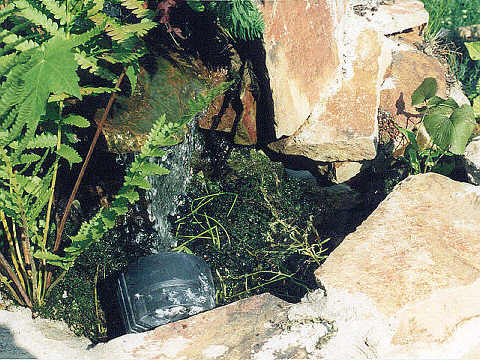|
The second level of the fountain is a flowing water peat
bog. The water falling from the first level, falls
into a bed of a mixture of live and decaying mosses,
setting on a bed or sandstone. The water falls into
a hole in the rocks which is filled with decaying peat moss.
Surrounding the fall area, live peat and
other mosses support a variety of wetland plants,
including Ferns - Matteuccia pennsylvanica,
Foam-Flower - Tiarella cordifolia, Mountain
Cranberry - Vaccinium vitis-idaea,
Sugar Maple - Acer saccharum and Red Maple - Acer
rubrum. There is also a specimen of what I think
may be Viola renifolia, though I am not sure,
since this one came up as a volunteer and I have not
seen its flower yet.
|
|
The water flows down through the moss bed, then into a
bed of limestone gravel after which it up wells from a
"spring" at the exit of the pool. The
bog is the Third Biological Filter. .I provides an
acidic input into the system, which is predominantly
alkaline. The resulting pH shock in this area, is
intended to suppress water born pathogens that might
injure the fish. Weekly fertilizer additions are
made into the up well spring area. This allows
ample opportunity for the fertilizer to be diluted
before it reaches the pond. Makeup water is also
added at this location. The notch in the rock
cap for this level serves to hold the garden hose in
place during this task.
Water exits from the up well spring via a narrow rocky
crevice. A portion of the flow, is allowed to
leak away from the stream and to seep from the
adjacent "cliff" seepage spring. In
the seepage area, Walking Fern - Asplenium
rhizophyllum and Liverwort - Marchantia
domingensis grow. Above the seepage, the rock face is
relatively dry. Here, Wild Columbine - Aguilegia
canadensis has taken
hold. There is room for some additional
plantings also. On the opposite side of the
stream from the seepage spring, a dry cliff face is
exposed. I have not planted anything in this
area, but have "inoculated" the cracks
between the rocks with decayed peat moss. We'll
see what decides to grow there..
At the end of the stream, a sharp edged lumpy rock, cantilevered
over the next pool, divides the water into several
dancing, pulsating streams. The resulting motion
creates a splashy waterfall with an area suitable for
plants that grow in water filtered light an very high
humidity conditions behind the falls. Here, you
will find Liverwort and Miniature Rock Cress- Arabis
glabra?.
Within the splash zone of the falls, Viola
cuculatta grows in the shade of Stinging Woods
Nettle - Laportea canadensis. The ground is very wet in this
area. On the other side of the stream, below the
dry cliff, just where the moisture is a little
heavier, a Christmas Fern - Polystichum
arostichoides is growing.
At the lower edge of the third level, are specimens of
Viola fimbriatula. When these were initially
planted, .they did very well, but now their leaves
have disappeared. I need to revisit their home
habitat to determine what their current status should
be. I may need to move them either toward or
away from the stream.
Unlike the other levels, the exit from the third level
is down a relatively gentle slope. The water
"decants" down a smooth rock chute
surface. This rock is typically covered with
algae and is the favorite feeding ground of small
aquatic snails. Sometimes, there are as many as
50 snails on that rock.
The fourth level, is meant to resemble a mountain rivulet.
It has .various sedum species growing, including Widow's
cross - Sedum ternatum and two unidentified ones.
|
 |
|
The Bog &
Crevice Stream
|
|


